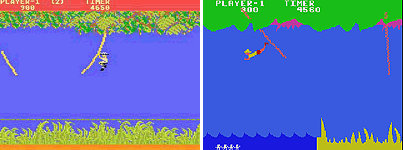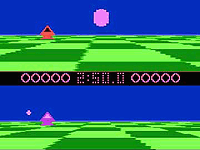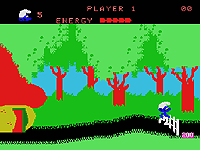|
COLECOVISION VS. ATARI 5200: HARDWARE COMPARISON - Back to page 2 Back to page 1
 Jungle Hunt for 5200 (left) and Colecovision (right) Where these are concerned, it appears the CV is the hands down winner. The CV can display 32 sprites at once out of a library of 64. Sprites can be 8x8 pixels or 16x16 pixels (all must be the same size). The 5200 by comparison uses a sprite system called player/missile graphics. These are functionally sprites, but different than the CV's. The 5200 has only four players and four missiles. Each player is eight pixels wide, each missile two. That's a total of eight "sprite" type elements on screen at once, as opposed to 32. However, as always, things are not so cut and dried. First, while the CV can display 32 sprites at once, only four can appear on a given scan line at once, whereas all of the 5200's players and missiles can appear on the same line. Second, while a CV sprite can be 16x16 pixels and 5200 players are only 8 pixels wide, both players and missiles are the full height of the screen! At maximum rez, a player is 8x256 pixels. Also, the four missiles can be combined into a "fifth player" that is 8x256 pixels and can contain four different colors (one per missile). As to colors, while both the CV and 5200 sprites are each a single color ("off" pixels are transparent), the CV's sprites are limited to the same 15 colors used for all other graphics, while each 5200 player and missile can use any of the machine's 128 colors, regardless of which other colors are on the screen. Furthermore, the 5200 can do a trick whereby a third color is generated for any pixels of players 0 and 1, and 2 and 3 that overlap, thus, it's possible to make three colored objects using two players. To make a 3 colored sprites on the CV requires three sprites to be "stacked".
A good programmer on the 5200 can do various tricks to get the four players and four missiles to act as more, basically by moving them between the time the TV draws one scan line and the next. Thus, a player/missile that acts as one object in one row gets re-used in a lower row. Thus, it can display four players and four missiles on a line, whereas the CV can only display four sprites on a line. (Theoretically, one could do this on the CV, but as only four sprites can be displayed on a line, and there can be 32 sprites on the screen, there's no reason to try. Furthermore, to do so would require precision coding and counting machine cycles to make it work...all this and you could still never have more than four sprites on a line!) Advantage: Neither
One of the biggest limitations of the Colecovision is that it does not contain what is known as "hardware collision detection". Collision detection is a means of determining when objects have made contact. On the 5200, whenever a player or missile collides with another or with one of the "playfield" graphic colors, the machine sets a value in a "collision" register. To determine if any collisions have occurred, a program need merely scan the collision registers. The CV has no hardware registers to do this task, so it is up to the programmer to write code to watch for such collisions. This means a CV game may end up using a lot of code and processor cycles to do something that's relatively "free" on the 5200. Advantage: 5200
In the preceding discussion of colors, graphics mode and sprites, the 5200's standard modes were discussed. However, the machine's graphics capabilities are more sophisticated than indicated thus far, primarily due to a DMA (direct memory access) chip called ANTIC. ANTIC is a microprocessor with a small instruction set that runs a program called a "Display List". The Display List is a series of instructions that tell the video chip (GTIA) how to draw the screen. For example, the Display List to draw the default text mode screen tells the video controller to skip 24 TV scan lines (the top border) , then display 24 rows of mode 0 (text). ANTIC's power lies in the fact that each graphics mode is not hardwired. Since the Display List is a program in the chip's memory, it is possible to rewrite it, making display modes into a custom screen type. For instance, a programmer might want text at the top of the screen, a small radar scope below it, then a large map, and finally a metallic control panel at the bottom. To accomplish this, a custom Display List is written, It uses one mode line of text, followed by a few lines of a bitmapped graphics mode for the radar, an additional 10 or so lines of multicolor character mode for the main map, and finally a dozen or so lines of a GTIA mode for the dashboard. An additional trick is to change the values in the color registers in the time between one scan-line on the TV being drawn and the next (known as the HBI, or horizontal blank interrupt). Changing the colors during this interval does not affect the scan lines drawn previously, thus it is possible to change the palette on each and every scan line of the display. So, while the current graphics mode may only allow five colors on the screen, a savvy programmer can put as many as 256 on a single screen. This can also be used in multi-color character mode, thus minimizing somewhat the CV's total colors advantage over the 5200 in such a mode. (As to if it's fair to use screen modes created with custom Display Lists in this comparison, recall that all the 5200's display modes are created by Display Lists. They are the standard method of setting up the screen. Setting up a custom Display List has no real impact on system performance, other than possibly affecting how much memory is taken to display the game screen.)
In summation, it's clear that from a hardware standpoint the 5200 has it over the Colecovision in many ways. The CV's distinction as the only cartridge based game system using totally off-the-shelf components handicaps it when compared to the 5200, which contains the specialized and very flexible custom parts of Atari's 8-bit computer line. In terms of flexibility, the 5200 is clearly the more powerful machine. Its larger color palette, numerous graphics modes (including several bitmapped ones), custom Display Lists, hardware collision detection and scrolling give it the capability of successfully executing a broader number of game types than the CV. In fact, it's tough to picture any game that was gone on the CV that could not have been done equally well (by a good programmer) on the 5200. Sure there would be some graphical adjustments (the 5200's multicolor graphics characters being half the horizontal rez of the CV's, for instance), but it could be done. The reverse is not quite true, as there are a few games on the 5200 that would be very difficult, if not downright impossible to do on the CV: Rescue on Fractalus, for instance.But, superior as the 5200 hardware is, that's not the end of the story. As the battle between the 2600 and intellivision proved, the power of the hardware isn't an issue to game players, it's the games. So even if the Colecovision can't do Display Lists and 256 colors, if you want to play Ladybug, Rock 'N Bolt or Donkey Kong, you had to go Coleco. Likewise, although Mr. Do's Castle was released for both systems, the CV version plays better. Conversely, while Miner 2049er also appears on both systems, the 5200 version is superior to the CV port. If you want to play Space Dungeon, Ballblazer, or Star Raiders, it's 5200 or nothing. So, overall, the 5200 is the more powerful hardware, but as it's the games that determine which system is better, the ultimate answer is likely to be slipperier. |


